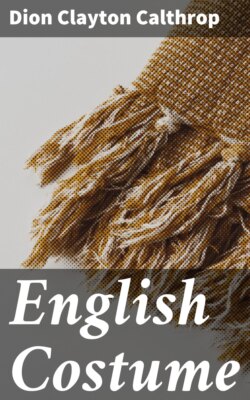Читать книгу English Costume - Dion Clayton Calthrop - Страница 24
На сайте Литреса книга снята с продажи.
THE MEN
ОглавлениеTable of Contents
The King had but little influence over dress in his time, seeing that he left England as soon as he was made King, and only came back for two months in 1194 to raise money and to be crowned again.
The general costume was then as plain as it had ever been, with long tunics and broad belts fastened by a big buckle.
The difference in costume between this short reign and that of Henry II. is almost imperceptible; if any difference may be noted, it is in the tinge of Orientalism in the garments.
There is more of the long and flowing robe, more of the capacious mantle, the wider sleeve.
No doubt the many who came from the Crusades made a good deal of difference to English homes, and actual dresses and tunics from the East, of gorgeous colours and Eastern designs, were, one must suppose, to be seen in England.
Cloth of gold and cloth of gold and silks—that is, warf of silk and weft of gold—were much prized, and were called by various names from the Persian, as ‘ciclatoun,’ ‘siglaton.’
Such stuff, when of great thickness and value—so thick that six threads of silk or hemp were in the warf—was called ‘samite.’
Later, when the cloth of gold was more in use, and the name had changed from ‘ciclatoun’ to ‘bundekin,’ and from that to ‘tissue,’ to keep such fine cloth from fraying or tarnishing, they put very thin sheets of paper away between the folds of the garments; so to this day we call such paper tissue-paper.
Leaf-gold was used sometimes over silk to give pattern and richness to it.
A MAN OF THE TIME OF RICHARD I. (1189-1199)
A curious survival of this time, which has a connection with costume, was the case of Abraham Thornton in 1818. Abraham Thornton was accused of having drowned Mary Ashford, but he was acquitted by the jury. This acquittal did not satisfy popular feeling, and the brother of Mary Ashford appealed. Now Thornton was well advised as to his next proceeding, and, following the still existent law of this early time of which I write, he went to Westminster Hall, where he threw down, as a gage of battle, an antique gauntlet without fingers or thumb, of white tanned skin ornamented with silk fringes and sewn work, crossed by a narrow band of leather, the fastenings of leather tags and thongs.
This done, he declared himself ready to defend himself in a fight, and so to uphold his innocence, saying that he was within his rights, and that no judge could compel him to come before a jury.
This was held to be good and within the law, so Abraham Thornton won his case, as the brother refused to pick up the gauntlet. The scandal of this procedure caused the abolishment of the trial by battle, which had remained in the country’s laws from the time of Henry II. until 1819.
It was a time of foreign war and improvement in military armour and arms. Richard I. favoured the cross-bow, and brought it into general use in England to be used in conjunction with the old 4-foot bow and the great bow 6 feet long with the cloth-yard arrow—a bow which could send a shaft through a 4-inch door.
For some time this military movement, together with the influence of the East, kept England from any advance or great change in costume; indeed, the Orientalism reached a pitch in the age of Henry III. which, so far as costume is concerned, may be called the Age of Draperies.
To recall such a time in pictures, one must then see visions of loose-tuniced men, with heavy cloaks; of men in short tunics with sleeves tight or loose at the wrists; of hoods with capes to them, the cape-edge sometimes cut in a round design; of soft leather boots and shoes, the boots reaching to the calf of the leg. To see in the streets bright Oriental colours and cloaks edged with broad bands of pattern; to see hooded heads and bared heads on which the hair was long; to see many long-bearded men; to see old men leaning on tan-handled sticks; the sailor in a cap or coif tied under his chin; the builder, stonemason, and skilled workman in the same coif; to see, as a whole, a brilliant shifting colour scheme in which armour gleamed and leather tunics supplied a dull, fine background. Among these one might see, at a town, by the shore, a thief of a sailor being carried through the streets with his head shaven, tarred and feathered.
